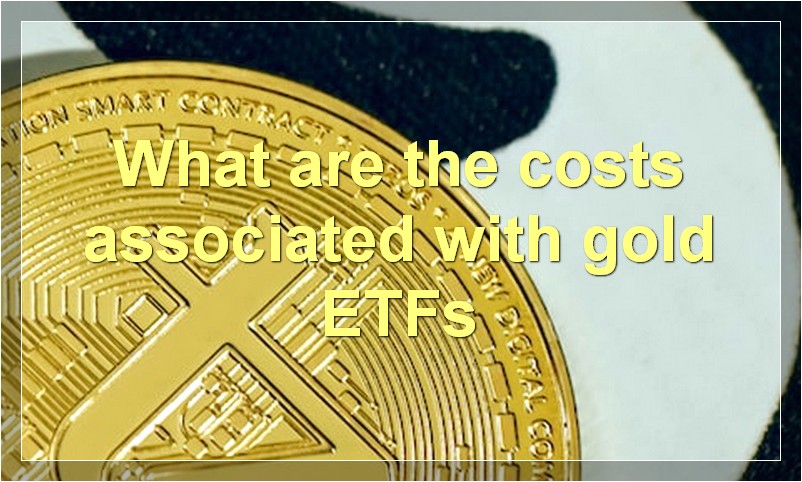If you’re looking to invest in gold in the new year, then you’ll want to check out these best gold ETFs for 2022. From experienced investors to those just starting out, these funds offer something for everyone.
What are the best gold ETFs for 2022
There are many reasons to invest in gold, and as we head into 2022, there are a few specific gold ETFs that look like they could be top performers.
Investors often turn to gold when they are worried about inflation or economic uncertainly, and both of those factors could be in play in the coming year. Gold prices have already been on the rise in 2021, and they could continue to climb in 2022.
The SPDR Gold Trust (GLD) is one of the largest and most popular gold ETFs. It invests primarily in physical gold bullion, and it has a low expense ratio of just 0.40%.
Another top contender is the iShares Gold Trust (IAU). This ETF also invests in physical gold bullion, and it has an even lower expense ratio of just 0.25%.
If you’re looking for a more actively-managed option, the VanEck Vectors Gold Miners ETF (GDX) could be a good choice. This ETF invests in companies that are involved in the gold mining industry, so it may be more volatile than some of the other options on this list. However, it does offer exposure to a different sector of the market, and it has a slightly higher expense ratio of 0.53%.
No matter which gold ETF you choose, you’ll be getting exposure to a precious metal that has a long history of holding its value. Gold could be a smart addition to your portfolio in 2022, especially if you’re looking for a hedge against inflation or economic uncertainty.
What are the benefits of investing in gold ETFs

If you’re looking to invest in gold, one option you might consider are gold ETFs. Gold ETFs are exchange-traded funds that invest in gold bullion and other gold-related assets.
There are a few reasons why investing in gold ETFs can be beneficial. First, they offer a convenient and cost-effective way to invest in gold. You can buy and sell shares of a gold ETF just like you would any other stock, and there’s no need to worry about storing or insuring your investment.
Second, gold ETFs can provide diversification for your portfolio. Gold is often seen as a safe haven asset, meaning it tends to do well when other investments are struggling. This makes gold a good choice if you’re looking to protect your portfolio from market volatility.
Finally, gold ETFs tend to have lower expense ratios than traditional mutual funds. This means you’ll keep more of your investment returns over time.
If you’re considering investing in gold, gold ETFs may be worth considering. Talk to your financial advisor to see if they’re right for you.
What are the risks associated with gold ETFs
Gold ETFs are exchange traded funds that invest in gold bullion and other gold-related assets. They offer investors a way to gain exposure to gold without having to take physical possession of the metal. Gold ETFs are subject to many of the same risks as other types of ETFs, as well as some unique risks.
One risk common to all ETFs is the risk that the underlying assets of the fund will lose value. This can happen if the price of gold falls or if the fund’s expenses eat into its assets. Gold ETFs are also subject to counterparty risk, which is the risk that the other party in a transaction will not fulfill their obligations. This is a particular concern with gold ETFs because many of them use derivatives to gain exposure to gold, and derivatives are often traded with leverage, which can magnify losses.
Another risk specific to gold ETFs is storage risk. Physical gold must be stored somewhere, and there is always the possibility that it could be lost or stolen. For example, in 2013, a reported $1.6 billion worth of gold was stolen from vaults at the Brussels Airport. When investing in a gold ETF, you are trusting that the fund’s managers are properly storing and safeguarding the gold.
Finally, gold ETFs may be subject to higher taxes than other investment vehicles. This is because gains on gold bullion are typically taxed at the collectibles rate of 28%, rather than the long-term capital gains rate of 15%.
What is the historical performance of gold ETFs
Gold ETFs are a type of investment that tracks the price of gold. They are typically traded on stock exchanges and can be bought and sold like any other stock.
Gold ETFs have been around since 2004, and their performance has been mixed. In general, gold ETFs have tended to outperform the gold spot price during periods of rising gold prices and underperform during periods of falling gold prices.
One reason for this is that gold ETFs generally have lower expenses than physical gold investments, such as gold coins or bars. This means that they tend to outperform during periods of rising gold prices when costs are a bigger factor.
Another reason is that gold ETFs are more liquid than physical gold investments. This means that they can be bought and sold more easily, which can lead to higher returns during periods of market turmoil when investors are looking to cash out of their investments.
What factors should be considered when choosing a gold ETF
When choosing a gold ETF, there are a few key factors to consider:
1. The type of gold ETF: There are two main types of gold ETFs – physical gold ETFs and synthetic gold ETFs. As the name suggests, physical gold ETFs invest in actual gold bullion, while synthetic gold ETFs use derivatives to track the price of gold.
2. The size of the fund: Gold ETFs come in all different sizes, from large funds with hundreds of millions of dollars in assets to small funds with just a few million dollars in assets. It’s important to choose a fund that is the right size for your investment goals.
3. The fees: Like all investments, gold ETFs come with fees and expenses. These can vary widely from one fund to another, so it’s important to compare the fees before investing.
4. The investment objectives: Each gold ETF has its own investment objectives and strategies. Some funds focus on growth, while others focus on income or preservation of capital. Make sure to align your investment goals with the fund’s objectives before investing.
What are the costs associated with gold ETFs

When it comes to investing in gold, there are a few different options to choose from. One popular option is to invest in a gold ETF, or exchange traded fund. But what exactly is a gold ETF, and what are the costs associated with investing in one?
A gold ETF is a type of investment that tracks the price of gold. They are traded on stock exchanges and can be bought and sold just like any other stock. Gold ETFs are popular because they offer a convenient way to invest in gold without having to physically own it.
The costs associated with gold ETFs vary depending on the specific fund you are investing in. However, there are some general costs that all investors should be aware of. First, there is the expense ratio, which is the annual fee that all ETFs charge. This fee covers the costs of running the fund, such as administrative expenses and management fees.
In addition to the expense ratio, investors also have to pay commissions when they buy or sell shares of a gold ETF. These commissions can vary depending on your broker and the specific fund you are trading. Finally, there may also be other miscellaneous costs associated with gold ETFs, such as bid-ask spreads and capital gains taxes.
Overall, the costs associated with gold ETFs are relatively low compared to other types of investments. However, it is important to do your research and understand all of the fees involved before investing in any type of security.
How do gold ETFs compare to other investment options
There are many different types of investment options available to investors, and each has its own set of pros and cons. Gold ETFs are one type of investment option, and they have some advantages and disadvantages compared to other options.
One advantage of gold ETFs is that they offer exposure to gold without the need to physically own it. This can be beneficial for investors who want to gain exposure to gold but don’t want the hassle of storing and safeguarding it. Gold ETFs also tend to be more liquid than physical gold, meaning that they can be bought and sold more easily.
However, there are also some downside to investing in gold ETFs. One is that they typically track the spot price of gold, meaning that investors will only make money if the price of gold goes up. Another potential downside is that gold ETFs may have higher fees than other investment options.
So, how do gold ETFs compare to other investment options? They have some advantages and disadvantages, but ultimately it depends on the individual investor’s goals and preferences.
What are the tax implications of investing in gold ETFs
Gold ETFs are a type of investment that allows you to invest in gold without having to physically own it. These funds are traded on stock exchanges and can be bought and sold like any other stock. Although gold ETFs offer many benefits, there are also some tax implications to be aware of before investing.
When you sell gold ETFs, you will be subject to capital gains tax. This is because the sale of these assets is considered a taxable event. The amount of tax you owe will depend on your marginal tax rate and how long you held the ETFs for. If you hold the ETFs for more than one year, you will be taxed at the long-term capital gains rate, which is typically lower than the ordinary income tax rate.
Another thing to keep in mind is that gold ETFs may be subject to state taxes as well. This depends on the state in which you live and the specific rules of that state. Some states exempt gold bullion from taxation, but others do not. Be sure to research the tax implications of investing in gold ETFs in your state before making any decisions.
When is the best time to invest in gold ETFs
There is no one-size-fits-all answer to this question, as the best time to invest in gold ETFs will vary depending on your individual investment goals and objectives. However, as a general rule of thumb, it is typically best to invest in gold ETFs when prices are low and expected to rise in the future. This strategy allows you to dollar cost average your way into a position, which can help to mitigate some of the risk associated with investing in gold.
How do I choose the right gold ETF for me
When it comes to investing in gold, there are a few different ways to do it. One option is to invest in a gold ETF. But how do you know which gold ETF is right for you? Here are a few things to consider:
-The type of gold ETF: There are two main types of gold ETFs – physical and synthetic. Physical gold ETFs invest in actual gold bullion, while synthetic gold ETFs use derivatives to track the price of gold.
-Your investment goals: Are you looking to simply track the price of gold, or are you looking to generate income from your investment? Different gold ETFs have different objectives, so make sure the one you choose aligns with your goals.
-Your risk tolerance: Gold is a relatively safe investment, but there is still some risk involved. If you’re risk-averse, you may want to stick with a physical gold ETF. If you’re willing to take on more risk, a synthetic gold ETF could be a better option.
-Cost: Gold ETFs come with various fees and expenses, so be sure to compare them before investing. You don’t want to pay more than you need to in fees.
By considering these factors, you can narrow down your options and choose the best gold ETF for you.

